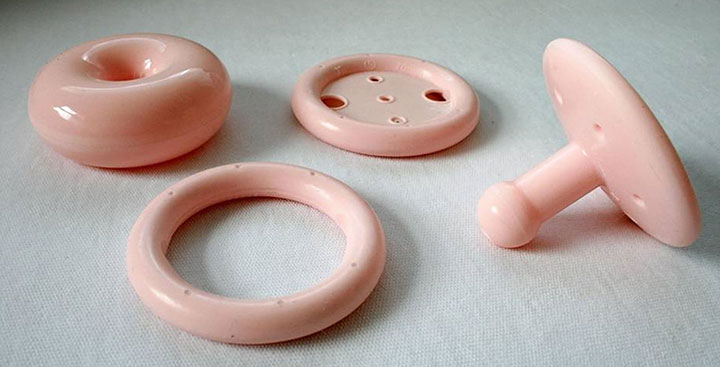
Can a pessary help with urinary incontinence?
Can a pessary help with urinary incontinence?
What is a pessary?
A pessary is a piece of medical grade silicone that is inserted into the vagina and used to help support the internal pelvic organs. This is a non-surgical and temporary device that is easy to use and remove. It can be inserted into the vagina to support the bladder, uterus, and rectum. Pessaries are a great minimially invasive option for pelvic organ prolapse and other pelvic issues.
Pessary and Urinary Incontinence
Pessaries are a great option for treating some types of urinary leaking. They help in two ways.
First, changes in bladder or urethral position that cause the bladder to drop can change the body’s ability to close the urethral opening. Using a pessary to support and reposition the bladder improves muscle activity and control.
Second, in cases of stress urinary incontinence, which causes leaking with extra forces downward, like
- Coughing
- Jumping
- Running
a pessary is used to provide pressure that helps the pelvic floor muscles close off the urethra, so that the downward force doesn’t overwhelm the muscles trying to stay closed at the bottom.
Is a Pessary safe to use?
Pessaries are generally safe and effective. They are made from non-pourous material, usually medical grade silicone. They are somewhat flexible and come in a variety of sizes and shapes to provide support in different ways.
Pessaries do require regular cleaning and maintenance. A person may remove, clean and replace their pessary on their own. They can choose daily, weekly, monthly or even longer. Pessaries can be inserted safely for up to 3 months, because the vagina is self cleaning, and silicone does not harbor bacteria.
They do not absorb fluid and therefore do not present the same risks as absorbent materials such as tampons. Pessary users are not at higher risk of toxic shock syndrome.
What is a pessary?
A pessary is a piece of medical grade silicone that is inserted into the vagina and used to help support the internal pelvic organs. This is a non-surgical and temporary device that is easy to use and remove. It can be inserted into the vagina to support the bladder, uterus, and rectum. Pessaries are a great minimially invasive option for pelvic organ prolapse and other pelvic issues.
Pessary and Urinary Incontinence
Pessaries are a great option for treating some types of urinary leaking. They help in two ways.
First, changes in bladder or urethral position that cause the bladder to drop can change the body’s ability to close the urethral opening. Using a pessary to support and reposition the bladder improves muscle activity and control.
Second, in cases of stress urinary incontinence, which causes leaking with extra forces downward, like
- Coughing
- Jumping
- Running
a pessary is used to provide pressure that helps the pelvic floor muscles close off the urethra, so that the downward force doesn’t overwhelm the muscles trying to stay closed at the bottom.
Is a Pessary safe to use?
Pessaries are generally safe and effective. They are made from non-pourous material, usually medical grade silicone. They are somewhat flexible and come in a variety of sizes and shapes to provide support in different ways.
Pessaries do require regular cleaning and maintenance. A person may remove, clean and replace their pessary on their own. They can choose daily, weekly, monthly or even longer. Pessaries can be inserted safely for up to 3 months, because the vagina is self cleaning, and silicone does not harbor bacteria.
They do not absorb fluid and therefore do not present the same risks as absorbent materials such as tampons. Pessary users are not at higher risk of toxic shock syndrome.
How can you get a pessary for urinary incontinence?
How can you get a pessary for urinary incontinence?
Over the counter pessary options
There are a few over-the-counter pessary options available, although they may not be suitable for everyone. These devices are typically sold at pharmacies or online retailers and purchased without a prescription. It does require some trial and error to identify the style, shape and size that will work best for your body. Discussing your concerns with you medical practitioner or a pelvic floor physical therapist can be helpful.
Some common over-the-counter pessaries include:
- Revive
- Poise Impressa
- Uresta
Each has a variety of sizes and often a starter pack to help you determine the best option for you.
It’s important to note that while over-the-counter pessaries may be a convenient option, they may not be as effective as prescription pessaries. Additionally, if you experience any discomfort or side effects while using an over-the-counter pessary, you should stop using it and consult a healthcare provider.
Over the counter pessary options
There are a few over-the-counter pessary options available, although they may not be suitable for everyone. These devices are typically sold at pharmacies or online retailers and purchased without a prescription. It does require some trial and error to identify the style, shape and size that will work best for your body. Discussing your concerns with you medical practitioner or a pelvic floor physical therapist can be helpful.
Some common over-the-counter pessaries include:
- Revive
- Poise Impressa
- Uresta
Each has a variety of sizes and often a starter pack to help you determine the best option for you.
It’s important to note that while over-the-counter pessaries may be a convenient option, they may not be as effective as prescription pessaries. Additionally, if you experience any discomfort or side effects while using an over-the-counter pessary, you should stop using it and consult a healthcare provider.

Prescription Pessary Options
Your healthcare provider can guide you to be best source for getting a prescription for a pessary. They will direct you to a specialist that understands how to assess your condition and determine the appropriate size and type of pessary to use.
It can take some trial and error to find the best shape and fit for your body. Try to be patient and communicate with your doctor, or the clinician providing the fitting. Working with an pelvic floor physical therapist is also helpful to develop effective pelvic floor good pelvic floor muscle habits, and problem solve if issues arise.
How often do I have to remove and clean a pessary?
Pessaries should be removed and cleaned regularly to prevent infection and ensure that they continue to work effectively. The frequency of removal and cleaning may vary depending on the type of pessary and your individual needs. In general, healthcare providers recommend that pessaries be removed and cleaned every 1-3 months.
During this time, you should check the pessary for any signs of wear and tear, such as cracks or tears, and replace it if necessary. To clean the pessary, you should remove it and wash it with mild soap and warm water, making sure to rinse it thoroughly. You may also use a specialized pessary cleaning solution or vinegar and water solution.
In some instances, a person requires assistance by a medical provider to place or remove a pessary. Scheduled visits for pessary maintenance will be determined by the patient and practitioner.
If you experience any discomfort or unusual symptoms while using a pessary, such as pain, bleeding, or discharge, you should contact your healthcare provider right away.
If you are experiencing urinary leaking, especially if your symptoms include a sensation of heaviness in the pelvis then a pessary is a great non-surgical option.
Prescription Pessary Options
Your healthcare provider can guide you to be best source for getting a prescription for a pessary. They will direct you to a specialist that understands how to assess your condition and determine the appropriate size and type of pessary to use.
It can take some trial and error to find the best shape and fit for your body. Try to be patient and communicate with your doctor, or the clinician providing the fitting. Working with an pelvic floor physical therapist is also helpful to develop effective pelvic floor good pelvic floor muscle habits, and problem solve if issues arise.
How often do I have to remove and clean a pessary?
Pessaries should be removed and cleaned regularly to prevent infection and ensure that they continue to work effectively. The frequency of removal and cleaning may vary depending on the type of pessary and your individual needs. In general, healthcare providers recommend that pessaries be removed and cleaned every 1-3 months.
During this time, you should check the pessary for any signs of wear and tear, such as cracks or tears, and replace it if necessary. To clean the pessary, you should remove it and wash it with mild soap and warm water, making sure to rinse it thoroughly. You may also use a specialized pessary cleaning solution or vinegar and water solution.
In some instances, a person requires assistance by a medical provider to place or remove a pessary. Scheduled visits for pessary maintenance will be determined by the patient and practitioner.
If you experience any discomfort or unusual symptoms while using a pessary, such as pain, bleeding, or discharge, you should contact your healthcare provider right away.
If you are experiencing urinary leaking, especially if your symptoms include a sensation of heaviness in the pelvis then a pessary is a great non-surgical option.

Holly McDonald, PT
Pelvic Rehab Specialist
HoHolly McDonald, PT
Pelvic Rehab Specialist
My practice is in Winston Salem NC. I see some patients virtually, but in-person is even better.
I am located at 501 Shepherd St. Winston Salem NC 27103. For more information, or to schedule an appointment please call the office at 336-414-2050, or email us at office@reliefpt.com.
My practice is in Winston Salem NC. I see some patients virtually, but in-person is even better.
I am located at 501 Shepherd St. Winston Salem NC 27103. For more information, or to schedule an appointment please call the office at 336-414-2050, or email us at office@reliefpt.com.

